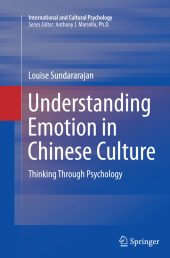 Neuerscheinungen 2016Stand: 2020-02-01 |
Schnellsuche
ISBN/Stichwort/Autor
|
Herderstraße 10
10625 Berlin
Tel.: 030 315 714 16
Fax 030 315 714 14
info@buchspektrum.de |

Louise Sundararajan
Understanding Emotion in Chinese Culture
Thinking Through Psychology
Softcover reprint of the original 1st ed. 2015. 2016. xx, 210 S. 1 SW-Abb., 6 Farbabb. 235 mm
Verlag/Jahr: SPRINGER, BERLIN; SPRINGER INTERNATIONAL PUBLISHING 2016
ISBN: 3-319-34918-X (331934918X)
Neue ISBN: 978-3-319-34918-3 (9783319349183)
Preis und Lieferzeit: Bitte klicken
This mind-opening take on indigenous psychology presents a multi-level analysis of culture to frame the differences between Chinese and Western cognitive and emotive styles. Eastern and Western cultures are seen here as mirror images in terms of rationality, relational thinking, and symmetry or harmony. Examples from the philosophical texts of Confucianism, Daoism, Buddhism, and classical poetry illustrate constructs of shading and nuancing emotions in contrast to discrete emotions and emotion regulation commonly associated with traditional psychology. The resulting text offers readers bold new understandings of emotion-based states both familiar (intimacy, solitude) and unfamiliar (resonance, being spoiled rotten), as well as larger concepts of freedom, creativity, and love.
Included among the topics:
The mirror universes of East and West.
In the crucible of Confucianism.
Freedom and emotion: Daoist recipes for authenticity and creativity. Chinese creativity, with special focus on solitude and its seekers.
Savoring, from aesthetics to the everyday.
What is an emotion? Answers from a wild garden of knowledge.
Understanding Emotion in Chinese Culture has a wealth of research and study potential for undergraduate and graduate courses in affective science, cognitive psychology, cultural and cross- cultural psychology, indigenous psychology, multicultural studies, Asian psychology, theoretical and philosophical psychology, anthropology, sociology, international psychology, and regional studies.
Part 1 Conceptual Foundations for the analysis of Chinese Emotions.- The Mirror Universes of East and West.- Harmony: A Delicate Dance of Symmetry.- In the Crucible of Confucianism.- On the Wings of Daoism.- Part II. Tracing Emotions daintily through Things Psychologically Chinese.- Heart-Aching Love ( Teng , ).- The Art of Intimacy.- Freedom and Emotion: Daoist recipes for Authenticity and Creativity.- Being Spoiled Rotten ( Sajiao ): Lessons in Gratitude.- Part III. Chinese Creativity.- Chinese Creativity, with special focus on Solitude and its Seekers.- Savoring ( Pin wei ), from Aesthetics to the Everyday.- Emptiness ( Kong ): Insight-based Emotional Transformations.- Part IV: Conclusion.- What is an Emotion? Answers from a Wild Garden of Knowledge.
"The book, on the whole, is insightful and dazzling in making interdisciplinary connections across psychology and related disciplines and it serves as a powerful example of articulating a sophisticated and elaborate theoretically informed indigenous psychology. ... it will be of importance to cognitive psychology, cultural psychology, indigenous psychology, theoretical and philosophical psychology, anthropology, and Asian studies and to ongoing scholarly debates on the cultural meaning of emotions." (Sunil Bhatia, Journal of Theoretical and Philosophical Psychology, Vol. 36 (4), 2016)
"Understanding Emotion in Chinese Culture by Louise Sundararajan is an elegant account of the ways in which emotions are experienced by Chinese people, and the book uses this discussion to enrich the Western psychological study of emotion. ... Understanding Emotion in Chinese Culture offers a rich network of complexly nuanced ideas. ... an eloquently constructed book that addresses difficult but important issues holistically within the context of naturalistic science. There are probably not many who would attempt such a task." (Richard E. Duus, PsycCRITIQUES, Vol. 60 (48), November, 2015)


